MIEL PAEK reviews Ensemble at The Perimeter, an exhibition where art turns the domestic space into theatrical immersion.
“It is not enough to demand insight and informative images of reality from the theater. Our theater must stimulate a desire for understanding, a delight in changing reality” Bertolt Brecht, Essays on the Art of Theatre (1954)
Nestled within the quiet charm of London’s Brownlow Mews, The Perimeter gallery unveils Ensemble (18 January – 4 April 2025), a poetic convergence of eleven contemporary artists whose works delicately unravel history’s fragmentary and fluid nature. Curated by Sasha Ercole, the exhibition transforms this terraced house into a vessel of layered storytelling, where art transcends its medium to evoke a theatrical intimacy.
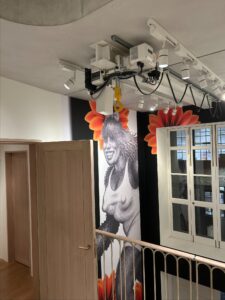
Extensions, 2021/2025
Digital print on Digimura
Courtesy R. Crumb. Image courtesy of the author.
Walking into The Perimeter, I felt an immediate sense of transition—a step away from the rush of the city into a space that is both personal and expansive. The house’s domestic character and the curated artworks was disarming, inviting a quiet contemplation as each room unfolded. When you enter, immediately Anthea Hamilton’s wallpaper work strikes you, covering the high ceilinged entrance to the house. It portrays a character from Robert Crumb’s 2000’s comic. Beautifully wrapping the unconventional setting of a domestic space, it invites viewers into a realm of quiet revelation.
Each room, steeped in the character of the house, becomes an intimate stage for the artists’ explorations. As I walked through light-filled rooms and ascended narrow staircases, the house itself seemed alive, its architecture mirroring the exhibition’s themes of layering and reconstruction. It felt as though I was part of the staging, a silent performer weaving through the acts.
Ensemble unfolds as a delicate choreography of ideas, structured across three thematic strands; Historiography & Archival Formats, Costuming & Choreography, and Storytelling & Composition. Its title, drawn from the Latin insimul (“together, at the same time”), evokes a shared act of creation and reimagining.
Tristan Pigott and Bendt Eyckermans engage with the Western canon, rendering gestures and compositions that question the permanence and objectivity of historical archives.
My personal favourite painting from the exhibition was a work by Tristan Pigott, made specifically for this exhibition titled God in the Machine. The work depicts a woman dressing herself. The delicate nature of the painting coupled with the intricate additional semicircle of figures across her body creates an intimate and gorgeous piece of work, layering the woman with trinket-esque overlays depicting animals, the large ship and the tiny sugar snap pea. This work held my gaze; his ability to manipulate the familiar into something quietly disarming left me questioning the reliability of what I thought I knew. Pigott’s ability to imbue such stillness with life and narrative is a rare gift.

Installations by Nikita Gale, JJ Guest, and Coumba Samba disrupt the invisible frameworks that shape our environments. These pieces felt like whispers in the space, soft yet insistent, demanding that I lean in closer to uncover their intricacies.
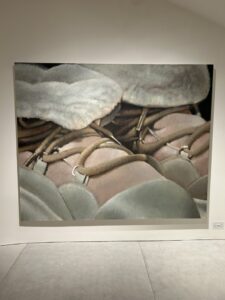
Issy Wood creates dreamlike juxtapositions of digital and physical imagery, where costuming transforms identity into a tableau of cultural memory. Her works translate the language of still life into a contemporary reflection on staging and artifice. Standing before her pieces, I found myself caught in their suspended tension, as though time had briefly paused. My adoration for Issy Wood dates back to 2021, an ode I wrote about for Era last year, and once again here she manages to enter the ensemble, using consumer culture as a device to uncover the entanglement between late capitalist desire and decay.
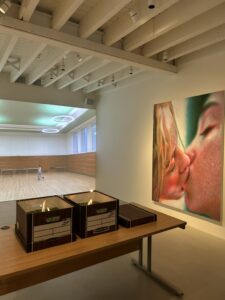
Adam Farah-Saad and Louise Giovanelli weave moments of temporal suspension through techniques of layering and sequencing, their compositions echoing the fluidity of choreography as narrative. These works felt like conversations, their layered elements overlapping in ways that demanded a slower, more attentive engagement. Giovanelli’s new work Harmony of two kissing figures has been elucidated by Louise herself, quoting “gestures reinforce the work’s relationship to the cinematic moment, simultaneously referencing the momentum of film and distilling its climax”.
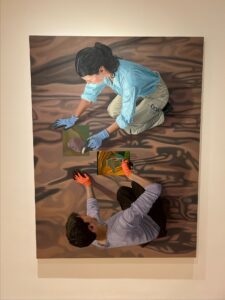
Rene Matić uses dance and photography as a tender resistance to colonial narratives. Their work felt like a quiet rebellion, each movement and captured moment brimming with unspoken defiance. Mohammed Sami creates landscapes imbued with quiet absence, where the unseen becomes the focus of memory and emotion. His paintings lingered with me, their silences speaking louder than words. Anthea Hamilton blurs the boundaries between public and private spaces, her installations lingering as poetic remnants of performances waiting to be rekindled. The textures and objects she leaves behind invite the viewer to imagine their activation, making the absence of performance a palpable presence.
Sasha Ercole’s curatorial genius transforms The Perimeter into an immersive, theatrical experience. The architectural quirks of the house create a culmination of history and imagination, amplifying the exhibition’s themes of time, identity, and human connection.
The top floor living room space makes one feel as if stepping into a carefully composed painting. Here, the dialogue between art and curation reaches a crescendo. I particularly liked the presence of the orange and blue desk, its molten-like contour demanding attention—simultaneously organic and futuristic. The desk anchors the room as a stage for curated living. The iMac perched upon it adds a contemporary, utilitarian layer, grounding the room in modernity, while the carefully placed objects—each seemingly chosen with intent—invite closer inspection. In front of the desk, the deep orange velvet sofa continues the thematic contrast. Set against a patterned carpet with hints of blue and orange, the sofa’s rich texture and warm tone inject a sense of comfort into the otherwise sleek and intellectual atmosphere. The juxtaposition of the soft, plush fabric with the hard, sculptural shapes around it creates a visual and emotional tension that feels alive.
Sasha Ercole’s curation doesn’t simply position objects within a room—it choreographs them. This living room space, in its entirety, feels like a conversation between the past and the future, chaos and order, functionality and imagination. As a participant, your movements through the room echo the themes of the exhibition, making you part of the art. The collision of colors, textures, and shapes creates a tension that is impossible to ignore—a tension that demands reflection, just as all great art should. In this curated dialogue, Ercole reminds us that design and art are not static; they are dynamic, evolving entities that challenge and inspire us to rethink our relationship with space, objects, and ourselves
Ensemble is a luminous exploration of history as an act of creation, a choreography of fragments that challenges us to rethink how stories are told and remembered. From Pigott’s tender and intricate compositions to the immersive installations of Gale and Samba, the exhibition resonates as a collective act of imagination. It is a journey through the past and into speculative futures, leaving behind a quiet yet profound reverberation. As I left The Perimeter, I couldn’t shake the sense that I had not just witnessed art, but experienced something much larger—a shared act of storytelling that continues to unfold.
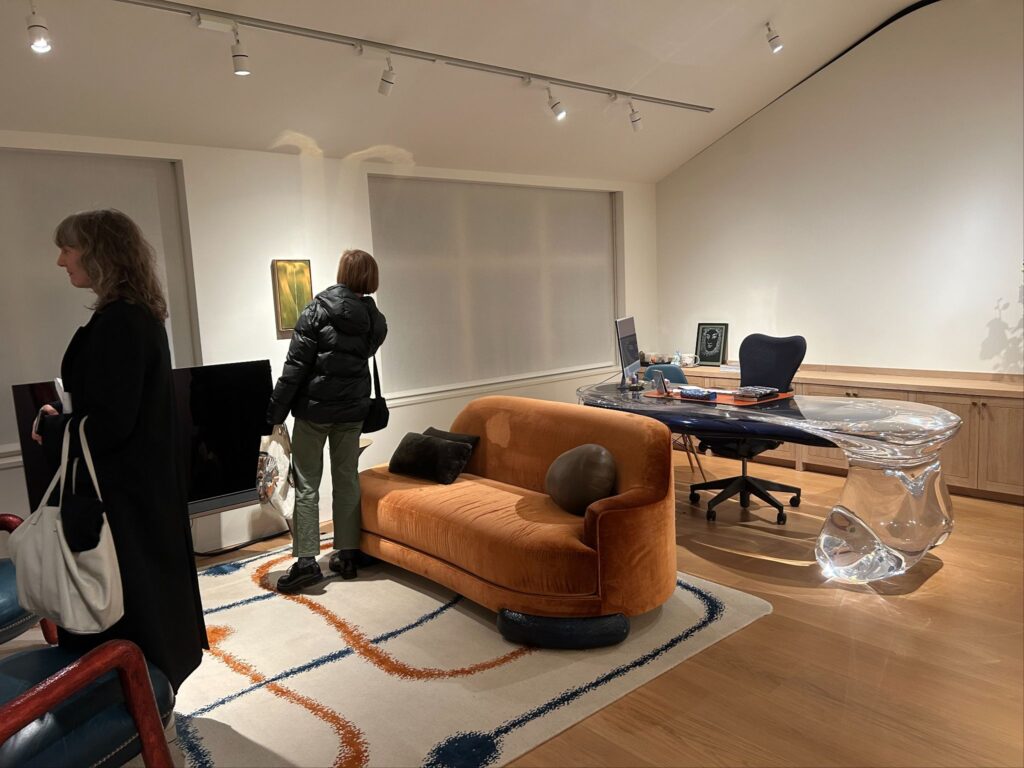
Ensemble runs from 18 January to 4 April 2025. Featured image courtesy of the author.

